FEATURES|COLUMNS|Dharma Project of the Month (inactive)
Palri Buddha Park - A Conservation Project in East Bhutan
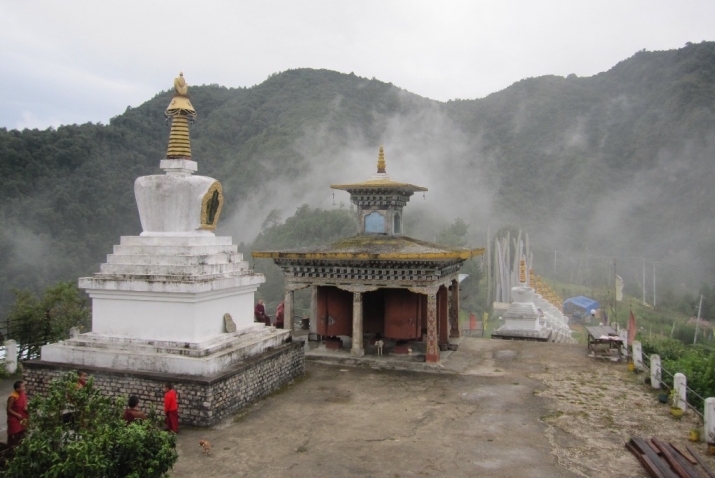 Samten Choeling Nunnery
Samten Choeling NunneryAs I paused to catch my breath in the thin air, I felt a little embarrassed and awed as an elderly nun overtook me with a bagful of sand on her back. There is no easy way up to Palri Buddha Park. You need to trudge your way up the steep slope to Samten Choeling Nunnery, past the Milarepa shrine and the meditation cave, and navigate through the dense forests. Venerable Odzer Palzang was already hard at work when I arrived, delicately sculpting the details of Prince Siddhartha’s ornamental belt. “Need to start work early,” he said as he continued working. “It may get too foggy in the afternoon.” At more than 3,000 feet above sea level, the weather can change with the winds anytime, even if it is clear blue sky in the morning.
The only such park in Bhutan, Palri Buddha Park is located in Wamrong, Trashigang District, in eastern Dungsamkha—one of the four traditional “gateways” to the landlocked country. Because of its remoteness, young people from this part of Bhutan choose to migrate to the more developed western regions, like Thimphu and Paro, where there are more job opportunities. “Bhutan is developing rapidly,” Venerable Palzang explained. “Before, we had few roads and vehicles, and less economic activities. When I was small, I loved exploring these mountains and forests on foot with my father. He taught me always to respect nature and the environment.”
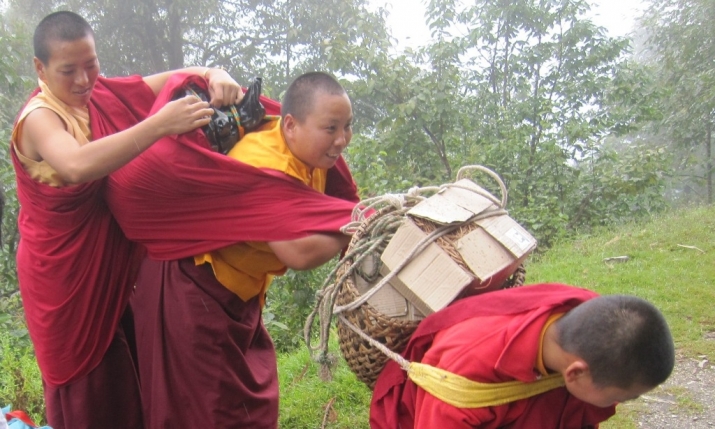 The nuns of Samten Choeling loading up before trekking up to Palri Buddha Park
The nuns of Samten Choeling loading up before trekking up to Palri Buddha Park“The mountains and forests are home not only to many animals, birds, and trees, but also to many deities, divinities, and spirits,” he continued. “In Bhutan, they are considered sacred places and are treated with utmost respect. We believe that they are protected by taboos because the guardianship of the hidden treasures [spiritual treasures hidden in the 8th century by Guru Rinpoche and Yeshe Tsogyal, to be revealed at an appropriate time] was entrusted to the local deities so that the doctrines of sutras and tantras of the Buddhist culture are protected for all times. That is why our forefathers warned us not to dig into the places underground where nagas [serpent spirits] dwell, for such action may harm us. If we disturb the local deities of the place and of the earth, it will give rise to earthquakes, electrical storms, or hailstorms. If we indulge in misconduct and immoral acts, we may be put in danger with disorders of the four natural elements. In recent years, there are more frequent epidemics in the region, which destroy humans, cattle, and crops. These natural calamities happened because we have disturbed the habitats of the gods, the nagas, and the local deities, and weakened the fertility and harmonious life essence of the earth.”
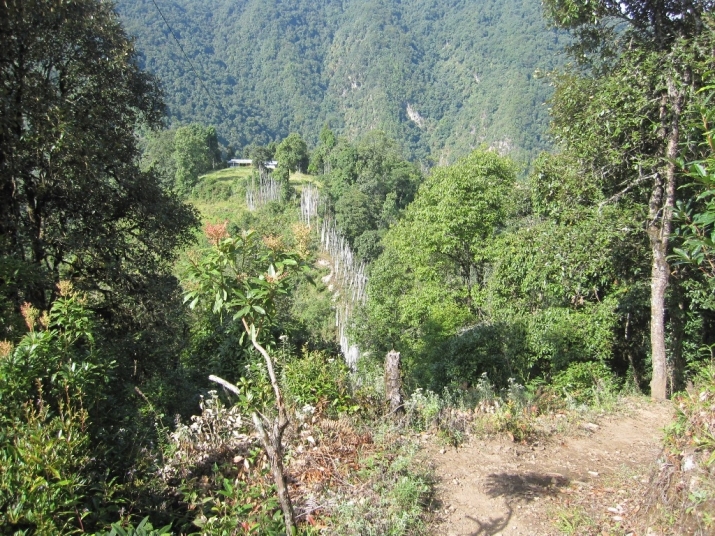 The trek to Palri Buddha Park
The trek to Palri Buddha ParkConscious of the adverse effects that development is having on the natural environment, Venerable Palzang, together with the nuns from Samten Choeling Nunnery, succeeded in convincing the local authorities to grant them a permit to build Palri Buddha Park as a conservation project, in order to protect the region. By so doing, they hope to prevent companies seeking to profit from the natural resources here from moving in. When completed, the park will also be a local attraction. Unlike popular destinations such as Paro, Punakha, Thimphu, and Bumthang, Wamrong has few holy sites where the local people can go to pay homage or to perform meritorious deeds. Within the park will be life-size statues depicting the Twelve Deeds of the Buddha,* each finely crafted and detailed by Venerable Palzang. He hopes that visitors will be inspired not only by the Buddha’s teachings but also by the beauty of the natural surroundings, and therefore realize the need to preserve the area for future generations. It will also be a refuge from the busyness of our modern lives, a place to retreat to where we can bring our minds home, back to peace and stillness.
A master architect of Buddhist stupas and temples, skilled in sculpture and Buddhist iconographical paintings, Venerable Palzang was the main architect for many temples and stupas in Ladakh and the only statue of Guru Rinpoche in Sikkim. His father Lopen Sonam Tashi, a renowned teacher and practitioner in the Wamrong region, was the founder of Samten Choeling Nunnery, which is halfway down the hill from Palri Buddha Park. When his father passed away in 2013, Venerable Palzang returned from his monastery in Sikkim to manage the nunnery and guide the 20 resident nuns.
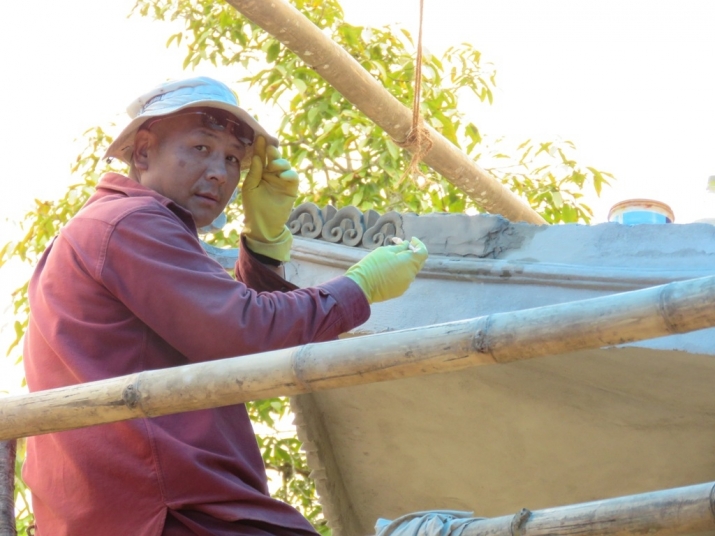 Venerable Odzer Palzang at work
Venerable Odzer Palzang at workWith limited financial resources, support for the park has come mainly from the local villagers, who contribute what they can to show their appreciation for the project. Despite their meager earnings, some have donated from 100 (approximately US$1.50) to 500 ngultrum, while others have offered labor, food, and drink. But without the efforts and determination of the nuns from Samten Choeling Nunnery, the project would not have got under way. With no access road for vehicles, all materials must be hand-carried up the rugged terrain to the site. The nuns (including Venerable Palzang’s 80-year-old mother), led by Ani Kunzang, take everything from cement bags to water tanks up to the park. Guided by Venerable Palzang, they have cleared the land, erected tents as protection from the rain, and helped lay the foundations. Through their tireless dedication, 70 per cent of the work has now been completed.
Their motivation is rooted in a shared belief that the sanctity of life, compassion for others, and respect for nature and social harmony take precedence over material wealth and comfort. Based on their Buddhist values, the Bhutanese mindset is to regard nature as a living system of which we are a part rather than as a resource to be exploited for material gain. They traditionally live in harmony with the mountains, rivers, and forests, with a deep sense of gratitude and appreciation for their environment, practicing conservation long before modern ideas of environmental protection came into being. Even today economic growth is regarded not as an end in itself, but as a means to improve the people’s well-being and welfare. Entwined with traditional values, development in Bhutan aims to achieve a balance between the spiritual and material aspects of life. This is reflected in the Gross National Happiness Index, initiated in the 1970s by His Majesty the Fourth King of Bhutan, Jigme Singye Wangchuck, which supports the concept that sustainable development should take a holistic approach towards ideas of progress and give equal importance to non-economic aspects of well-being.
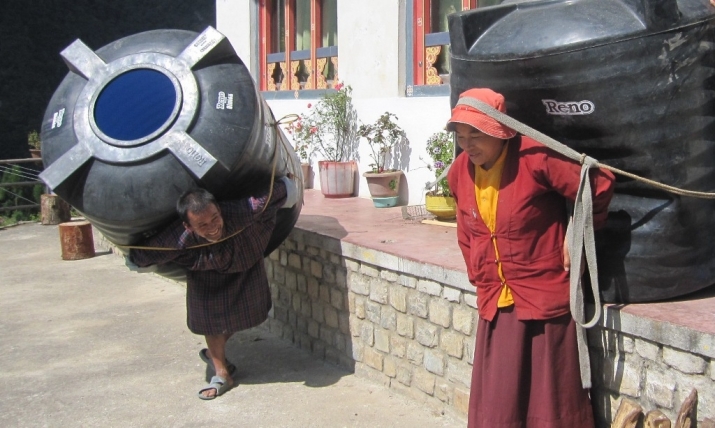 Head nun Ani Kunzang and a helper bringing water tanks up the mountain
Head nun Ani Kunzang and a helper bringing water tanks up the mountainThe Buddhist principles of harmlessness, karma, rebirth, and the interconnectedness of all things have taught the Bhutanese that the Earth does not belong to humankind alone but is shared by an infinite spectrum of beings, both visible and invisible, to whom we should extend our compassion and kindness. The destruction of the natural environment disrupts not only those beings we can see, but also the peace and harmony of many unseen beings, such as the local deities living in the lakes, cliffs, and every nook and cranny in the mountains.
On the drive back to Thimphu, I noted the truckloads of granite and rocks on the road and the exposed faces of blasted mountain sides. Despite the government’s effort to protect Bhutan’s distinct culture and environment in their carefully charted path of development, there will inevitably be challenges. I am reminded of Venerable Palzang’s caution: “If we are not careful, Bhutan could be overwhelmed by the forces of change and modernization. We must be ever-conscious of this danger, and make a deliberate effort to keep alive our traditional attitudes and values. Otherwise we will destroy not only the natural environment, but also ourselves.”
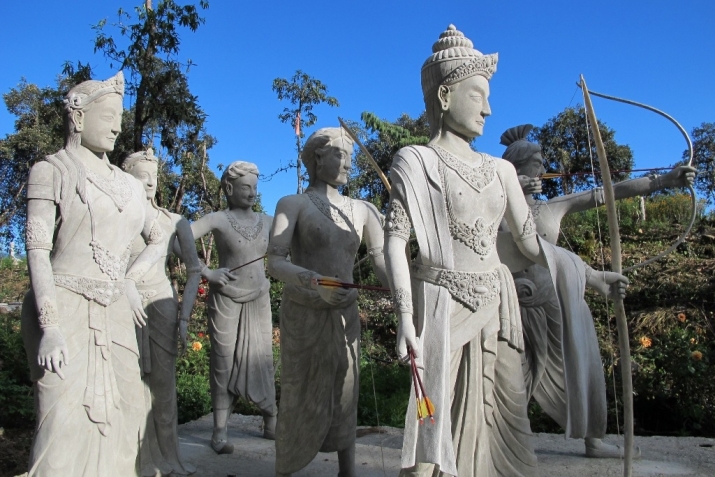 The young prince Siddhartha showing his archery skills, Palri Buddha Park
The young prince Siddhartha showing his archery skills, Palri Buddha Park*The Twelve Deeds of the Buddha are: the descent from Tushita, entering the mother’s womb, taking birth, becoming skilled in various arts, delighting in the company of royal consorts, developing renunciation and becoming ordained, practicing austerities for six years, proceeding to the foot of the Bodhi tree, overcoming Mara’s hosts, becoming fully enlightened, turning the wheel of Dharma, and passing into mahaparinirvana.
Images courtesy of the author.














